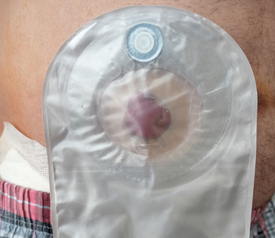
Adjusting to a new ileostomy can take a little time, but understanding how to care for your stoma can make the adjustment much easier. With the right ostomy supplies and ostomy care, you can competently care for your stoma at home. All it takes is a little knowledge and a little practice. In this article, we focus on the main issues that arise when caring for an ileostomy stoma.
Getting to know your ileostomy
An ileostomy is a surgical procedure to connect your small intestine to a newly formed hole in the side of your abdomen, called a stoma. Waste passes out through this stoma and into a bag that you wear. Most ileostomy systems have two parts: the flange and the pouch. The flange is a circle that goes around the stoma. The flange sticks directly to your skin. The pouch is a small bag that attaches to the flange.
Stoma care is important
Before you leave the surgical center, make sure your stoma nurse explains how to care for your new ileostomy, how to replace the flange, and how to place and remove the pouch. The stoma will need a little time to fully heal, but you will begin using it almost right away. The skin around the stoma will be tender and slightly inflamed after surgery. It is also normal for the delicate blood vessels to bleed a little bit (a lot of blood is not normal, however). Despite this, it is important to tightly affix the flange to your skin. Gently but thoroughly clean and dry the skin around your stoma. Once the skin is completely dry, you can affix the flange. Placing medical tape around the outer edges of the flange can help it hold more securely. If placed properly, the pouch usually stays firmly attached to the flange.
Living without a colon
Having an ileostomy means that you don’t get the digestive benefits of the colon (i.e. large intestine). The colon is responsible for absorbing much of the water out of the stool. This means that the contents of an ileostomy pouch can be looser than normal feces. Many people want to eat a high fiber diet to counteract this; however, your surgeon or ostomy nurse will likely recommend a low fiber diet initially, until your small intestine has fully healed (usually within 6 to 8 weeks). After that, though, a diet with adequate fiber is a good way to promote bowel health. The stools produced through an ileostomy will not be fully formed, but they will be more manageable) as the bowel heals (i.e., the consistency of thick oatmeal.
Living without a colon can change the balance of water and electrolytes (salt, potassium, etc.) in your body. Ask your doctor about ways to make sure you are getting enough water and electrolytes.
Your diet affects your new ileostomy
Once you have been cleared by your doctor, you can eat the same foods you enjoyed before your ileostomy surgery. Be aware, though, that the foods you eat will affect your digestive tract.
We all pass gas, but people without an ileostomy can hold it until it can be discreetly passed. People with an ileostomy, however, no longer have that ability. Therefore, people with an ileostomy may want to limit or avoid foods that create a lot of intestinal gas, such as:
- Asparagus
- Beans
- Beer
- Bran
- Broccoli
- Brussels sprouts
- Cabbage
- Carbonated beverages
- Dairy
- Onions
- Whole grains
Peels and rinds have a lot of fiber, so fruits and vegetables should be peeled before eating to reduce gas formation and incomplete digestion.
You may find that you want to make your stool thicker or thinner for convenience or to make cleaning easier. The foods you eat can help you manage this process.
Foods that thicken the stool include:
- Applesauce
- Bananas
- Cheese
- Rice
- Potato
Foods that thin the stool include:
- Fried foods
- Fruit juices (with natural or added sugar)
- Foods with high amounts of sugar
Keep in mind, though, that everyone’s digestive system is different. Now that you have a new ileostomy, you will need to learn how your new digestive system reacts to certain foods. Yet once you discover how food affects your ileostomy, you can use your diet to your advantage!
Keep ostomy supplies with you wherever you go
The key to keeping an ileostomy in place is making and maintaining a tight seal between the flange and your skin. Inflamed, delicate skin around the stoma soon after surgery makes getting a tight seal a little challenging. Even after the stoma has healed, sweat, moisture, and feces can loosen the ostomy—sometimes when you don’t expect it. Therefore, it is always a good idea to carry a small bag that contains all the ileostomy supplies you may need, including:
- Extra pouches
- An extra flange (precut)
- A mirror (to help you see the stoma if you can’t get to a bathroom)
- A roll of medical tape (or precut strips of medical tape)
- Wet wipes (to clean the skin)
- Sterile gauze (to dry the skin)
Include Hy-Tape in your ostomy supplies
Once you recover from surgery, you can return to almost all the activities you enjoyed before surgery. Once you learn proper ostomy care, the ileostomy will hardly be noticeable. In fact, you’ve probably encountered people with ostomies and didn’t realize it. The key to keeping your ileostomy discreet is to keep the entire ostomy system contained. Hy-Tape helps keep the system secure, contained, and discreet.
Hy-Tape is high-quality medical tape ideally suited for ostomy sites and ileostomy securement. The Original Pink Tape® is zinc-oxide based, and can be used on the inflamed, sensitive skin around new stomas. You can affix Hy-Tape over the edges of the flange and on the surrounding skin. When it is time to change the flange, Hy-Tape releases gently and cleanly, without skin trauma.
Even though Hy-Tape is gentle on skin, it holds fast, even under the demanding ileostomy environment. Hy-Tape is occlusive, which means it can resist soiling better than some tapes. As Hy-Tape warms to body temperature, the adhesive actually holds better, making it a great choice for a flange-pouch system that will almost always be kept covered. Many people are surprised to learn that they can shower with an ileostomy if they keep it covered. Hy-Tape holds secure even when cleaned with soap and water.
If you are caring for an new ileostomy, Hy-Tape wants to show you how The Original Pink Tape® can help you care for your ostomy. For a complimentary sample of Hy-Tape, simply fill out our request form.

